Chapter: 11 th 12th std standard Bio Botany plant tree Biology Higher secondary school College Notes
Secondary growth in dicot stem
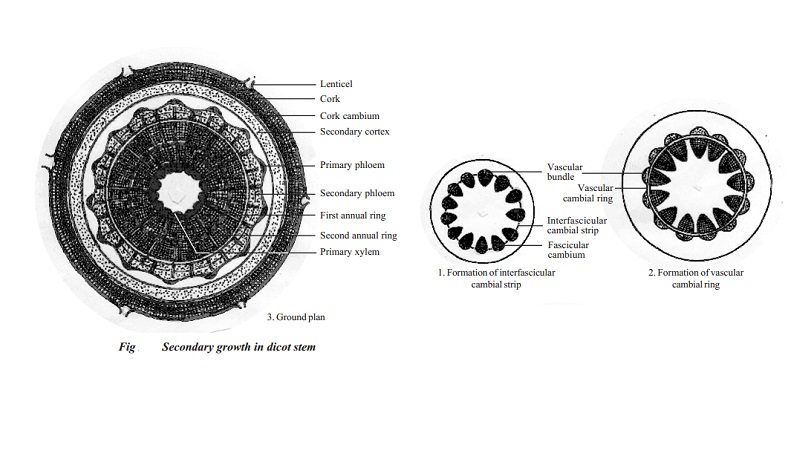
Secondary growth in dicot stem
The primary structure of the plant body is caused by the activity of apical meristems. The primary permanent tissues produced by the apical meristems cause the growth in length and to some extent in thickness. This is called primary growth. Further thickness is observed mostly in dicot plants. This thickness is caused by the addition of new tissues by the activity of the lateral meristems like vascular cambium and cork cambium. The new tissues, which are formed by the lateral meristems, are called secondary tissues.
Thus the increase in thickness, due to the addition of secondary tissues by the activity of vascular cambium and phellogen in the stelar and cortical regions is called secondary growth. The process and the structures associated with the secondary growth in dicot stems are given below:
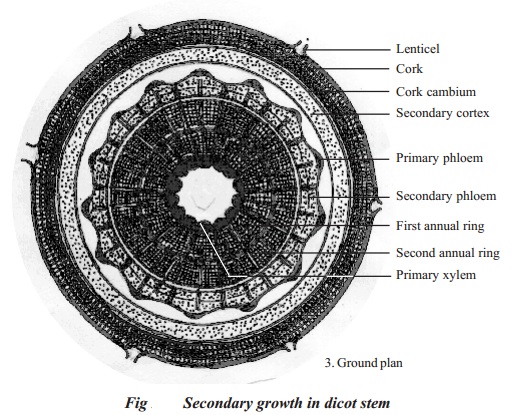
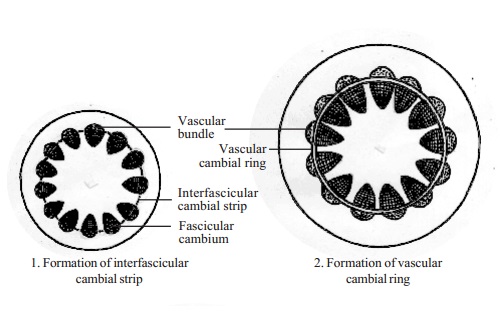
Formation of vascular cambial ring
The cambium occurring between the xylem and the phloem in the vascular bundle, is called fascicular cambium. In between the vascular bundles, a few parenchymatous cells of the medullary rays that are in line with the fascicular cambium become meristematic and form a strip of cambium. It is called interfascicular cambium. This interfascicular cambium joins up with the fascicular cambium on both sides and forms a continuous ring. It is called a vascular cambial ring.
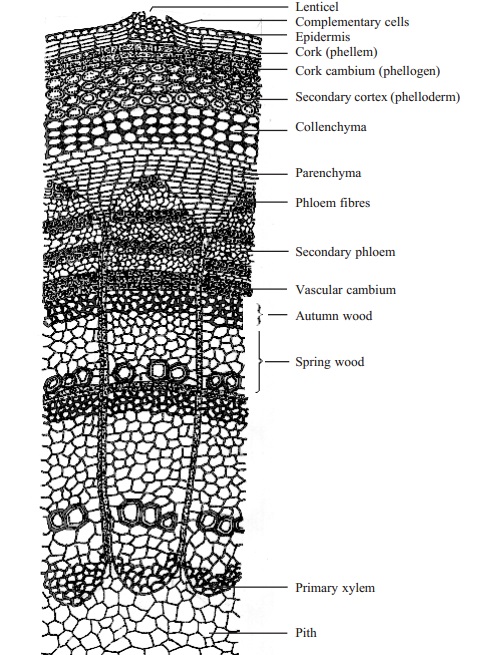
Formation of secondary tissues
The vascular cambial ring becomes active and begins to cut off new cells both towards the inner and outer sides. The cells, which are cut off towards the outerside, get differentiated into the secondary phloem, whereas those cut off on the inner side are differentiated into secondary xylem.
Secondary phloem consists of sieve tubes, companion cells, phloem parenchyma and phloem fibres. Secondary xylem occupies the major part of the woody stem. It consists of vessels, tracheids, xylem fibres and xylem parenchyma.
Formation of periderm
As secondary vascular tissues are continuously added in the stelar region, pressure is exerted on the cortex and epidermis. So the epidermis gets ruptured and the cortex stretched. Then the secondary protective layer is developed. It is called periderm.
During the formation of this periderm, a few layers of meristematic tissue are formed in the cortex. This is called cork cambium or phellogen. The cells of the cork cambium cut off cells on both the sides. Those formed on the outerside become suberised. This region is called cork or phellem. The cork cells are uniform in size and arranged in radial rows without intercellular spaces. These cells are dead at maturity. The cells that are cut off on the inner side of the cork cambium are parenchymatous.
This region is called phelloderm or secondary cortex. The cells of the phelloderm are living, isodiametric and radially arranged with intercellular spaces. As these cells have chloroplasts, they carry out photosynthesis. Their cell walls are made up of cellulose.
The cork (phellem), cork cambium (phellogen) and the secondary cortex (phelloderm) are together called periderm. All the tissues outside the vascular cambium i.e., secondary phloem, cortex and the periderm are together called bark.
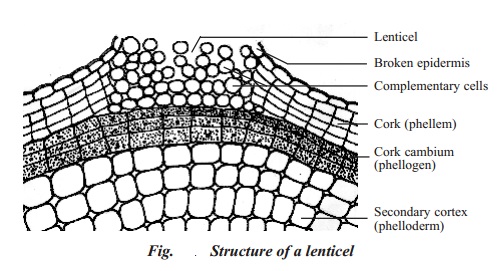
Lenticels
Lenticels are the lense shaped openings or breaks in the cork tissue. They are formed due to the rupture in the epidermal layers during the secondary growth in stems. They appear as small protrusions on the stem. Lenticels are usually formed below the stomata or sometimes at any region under the epidermis. Phellogen is more active in the region of lenticels than elsewhere and thus forms a mass of loosely arranged thin walled
parenchymatous cells called complementary cells. Lenticels are useful in exchange of gases. Lenticels remain scattered or arranged in the longitudinal or vertical rows.
Annual rings
During the spring and the summer seasons vegetative growth of a tree is induced and more leaves are produced. So there is a dire need of efficient transport of water and mineral salts. So the vessels produced during these seasons are larger and wider than those produced in the winter and the autumn seasons. Xylem elements of spring wood are larger, thin-walled and lighter in colour. On the otherhand, during the winter and the autumn seasons less amount of xylem elements is produced. These xylem elements are smaller, thick-walled and darker in colour. The xylem (wood) formed during the spring and the summer is called early wood or spring wood and that produced during the winter and the autumn is called late wood or autumn wood. These two kinds of wood appear together as a concentric ring called annual ring or growth ring.
Each annual ring refers to one year's growth. By counting the total number of annual rings, the age of the plant can approximately be calculated. The determination of the age of a tree by counting the annual rings is called Dendrocronology. The section taken at the base of the trunk of American Sequoia dendron has revealed that the tree is about 3500 years old.
Tyloses
In many dicot plants, the lumens of the xylem vessels are blocked by many balloon like in-growths from the neighbouring parenchymatous cells. These balloon like structures are called tyloses.
Usually these structures are formed in secondary xylem vessels. In fully developed tyloses starch, crystals, resins, gums, oils, tannins and coloured substances are found.
Sap wood and heart wood
Xylem is also known as wood. When the secondary growth occurs for several years, sapwood and heartwood can be distinguished in the secondary xylem. The outer part of the wood, which is paler in colour, is called sapwood or alburnum. The centre part of the wood, which is darker in colour, is called heartwood or duramen.
The sapwood is useful in the conduction of water. As vessels of the heartwood is blocked by tyloses, water is not conducted through them. The tyloses contain oils, gums, tannins, resins and other coloured substances. Due to the presence of these substances, the heartwood becomes the hardest part of the wood. From economic point of view the heartwood is more useful than sapwood. The timbers from the heartwood are more durable and more resistant to the attack of microorganisms and insects than those from sapwood.
Related Topics